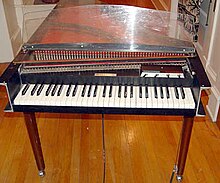| Baroque pop | |
|---|---|
 | |
| Other names |
|
| Stylistic origins | |
| Cultural origins | 1960s, United Kingdom and United States |
| Derivative forms | |
| Other topics | |
Baroque pop (sometimes called baroque rock) is a fusion genre that combines rock music with particular elements of classical music.[1][4][5] It emerged in the mid-1960s as artists pursued a majestic, orchestral sound[4] and is identifiable for its appropriation of Baroque compositional styles (contrapuntal melodies and functional harmony patterns) and dramatic or melancholic gestures.[3] Harpsichords figure prominently,[6] while oboes, French horns, and string quartets are also common.[5]
Although harpsichords had been deployed for a number of pop hits since the 1940s, some record producers in the 1960s increasingly placed the instrument in the foreground of their arrangements.[6] Inspired partly by the Beatles' song "In My Life" (1965), various groups were incorporating baroque and classical instrumentation by early 1966.[7] The term "baroque rock" was coined in promotional material for the Left Banke, who used harpsichords and violins in their arrangements[8] and whose 1966 song "Walk Away Renée" exemplified the style.[6][9]
Baroque pop's mainstream popularity faded by the 1970s, partially because punk rock, disco and hard rock took over; nonetheless, music was still produced within the genre's tradition.[9] Philadelphia soul in the 1970s and chamber pop in the 1990s both reflected the spirit of baroque pop,[4] while the latter incorporated much of the period's low fidelity musical aesthetic.[10]
- ^ a b Jackson 2015, p. 22.
- ^ Staff. "Chamber Pop Music Guide: 7 Notable Chamber Pop Artists". Masterclass. Retrieved December 5, 2022.
- ^ a b c d e Hawkins 2015, p. 193.
- ^ a b c d e f g Cite error: The named reference
AMBaroquePopwas invoked but never defined (see the help page). - ^ a b c Smith, Steve (29 November 2012). "Steve Smith: Wyman and Taylor join the Rolling Stones onstage; Coldplay takes a break" > "Now Playing". Pasadena Star-News. Archived from the original on 3 December 2012. Retrieved 20 May 2016.
- ^ a b c Cite error: The named reference
Boston Globewas invoked but never defined (see the help page). - ^ Gendron 2002, pp. 174, 343, various groups using baroque instrumentation in early 1966; Harrington 2002, p. 191, baroque rock inspired by "In My Life".
- ^ Unterberger 2014, p. 416.
- ^ a b Cite error: The named reference
Stanley2007was invoked but never defined (see the help page). - ^ Cite error: The named reference
am chamberpopwas invoked but never defined (see the help page).